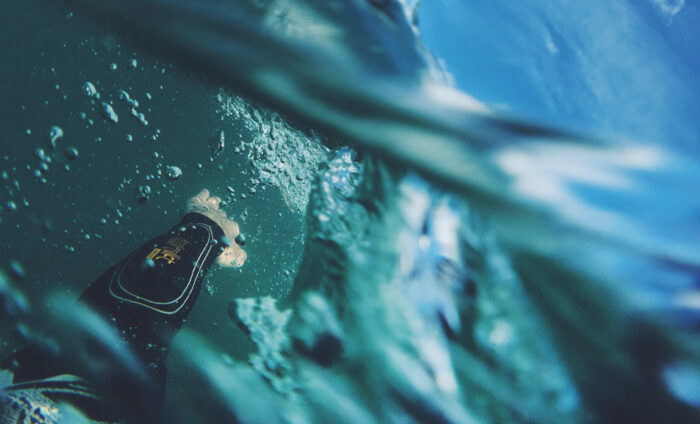
Wetsuits in the English Channel
"Non!" says Hannah Young
The English Channel is the ultimate long distance swim and people come from all over the world to attempt it. It’s not just the distance but the conditions that make it such a challenge: the changeable sea, the cold, the tides, jellyfish and the busy shipping lanes.
Signing up for the Channel is a huge commitment. It’s all you think about when you wake up and when you go to bed. That’s how it was for me anyway. My iPhone alarm for early swims was labelled “swim”, and it became the alarm and the standard instruction for my day: wake up, swim, eat, take children to school, swim, eat, nap, pick children up from school, put children to bed, swim, eat, sleep. And repeat. Over and over again. At weekends I drove to the coast to swim for up to seven hours before driving home again.
My morning swim would be in the Thames all year round. I regularly swam in 4-degree water. Under the watchful eye of a generous friend, I would get into the near-freezing water saying to myself “I will be a Channel swimmer”.
When you say you are going to swim the Channel, most people react with “I couldn’t stand the cold” and that is what I used to think until I put in the time and effort to become acclimatised. When I started swimming I used to gasp in a wetsuit in 17 degree water, but I ditched the neoprene and over five years entered longer and colder BLDSA swims and endured tough training conditions and cold baths until I could swim with ease in 4-degree water. I worked hard in the gym, pool and river and ensured I had plenty of good food to keep me fuelled and didn’t lose weight. If I gained a pound or two, all the better. People go to extraordinary lengths to make sure they are ready to swim the Channel: fitter, fatter, faster – whatever it takes.
But does that mentality of “whatever it takes” mean browsing the wetsuit rail? How about the latest, most expensive wetsuit, designed to help you achieve a better swimming position, with cuffs that prevent water entry and go-faster forearm panels or perhaps a thicker one to help keep you warm? WHAT? Really? Is that in the spirit of pitting your body against the elements to achieve that most iconic of swims? I don’t think so.
Wetsuits turn a swimmer with a poor body position into an efficient one. It takes away the element of cold and with that the pressure of having to make the swim as quickly as possible. No need to worry about making the tide when you can sit it out. It’s like doing a marathon in roller skates; you may cover the distance under your own steam but it wouldn’t make you a marathon runner.
The conditions are a huge part of the swim and if you protect yourself from them you are not really immersing yourself in it, if you will excuse the pun. If you are a triathlete and want to swim the Channel then by all means do the Arch to Arc. Wetsuits are permitted, although Mark Bayliss and Rachel Hessom have done it without.
If wetsuit swimmers were allowed to have recognised Channel swims they would quickly outnumber the skins swimmers and would break all the records because – surprise – a wetsuit makes it easier. Most of my local friends swim in wetsuits. I love that people will come and join me for that frog’s-eye-view dawn river swim – there’s nothing better and I don’t care what they wear. But when it comes to swimming the English Channel, let’s keep this iconic swim worthy of being iconic, leave the wetsuits behind and just try harder.
Hannah Young started open water swimming after she had her second child to get some fitness back and challenge herself. It started with the Henley Classic in 2009 and led to an English Channel swim, in 15 hours and 3 minutes, in August 2014.
"Oui!" says Tom Kean
Let me start by saying that I admire and respect both suits and skins swimmers equally. I accept that if you were to take two identical swimmers, swimming the same course, the skins swimmer must surely be on the moral high ground with greater bragging rights. In a similar way to climbing Mount Everest: the one who does it without oxygen, or in a single day, or with a disability, or even in hobnail boots and a tweed jacket, must surely be held in higher esteem than the rich, midlife crisis business person who has decided to chuck lots of money at it. But climb the mountain they have, and it’s recognised by those who need to know.
I’ve always had a slight problem with the blurring of lines when it comes to swimming the Channel. Who can forget the images of swimmers slathered in goose fat, designed entirely to combat the cold regardless of its true thermal efficacy? And those who use the pilot’s boat to shield them from the worst of the swell, or indeed those who choose to ride the bow wave to apparent great effect?
Talking with swimmers of all persuasions, there is clearly a polarity of opinion. There are Channel swimming rules, and everyone else; which is handy in one sense as all our events at Henley Swim cater for both. Happily for me, I’m agnostic and embrace all creeds without a hint of prejudice. But when I engage in conversation with a Channel swimmer, I’m normally left fearing for my soul, having just sold it, apparently, to the devil of neoprene.
I know this is an un-winnable argument, because by any measure swimming in skins is ‘harder’ than wearing a wetsuit. But by failing to embrace the new world of swimmers who choose to stay warm (or extend their effective season by four months each year) we risk losing the engagement of a whole new swathe of participants. And by driving away neoprene users we risk damaging the skins swimmer as well.
If it were me in charge, I’d set standards for both suits and skins and start to embrace some modern technology. You can’t deny its existence and by doing so you risk the reputation and credibility of all. I know all the arguments about where the line stops but – trust me – it’s easier to enforce suits rules than it is skins. The debates we have at our events are always with skins who haven’t quite read the rules; the wetsuit swimmers however, are always happy, sound in the knowledge that using hand paddles and fins is clearly not proper swimming (although one or two have tried over the years).
Neoprene is here to stay, and quite right too – it is wonderful stuff. If it weren’t for neoprene we wouldn’t be in the midst of the incredible growth in open water swimming we are all witnessing. By far and away the biggest barrier to entry for getting people to try open water swimming is the cold. Neoprene helps with that but also affords us (and I include event directors most definitely in this) real advantages. People in neoprene tend to float when they get into trouble and they experience far less cold water shock. And they mostly don’t get hypothermic. It is hugely tempting to insist on wetsuits for everyone, but as our love extends to all creeds we persist with both – and proudly so. If only Channel swimmers could show the same tolerance…
Tom Kean is co-founder of Henley Swim, which organises The Henley Classic, Thames Marathon and other open water swimming events. He is also co-founder of Henley Open Water Swimming Club and a regular open water swimmer.







